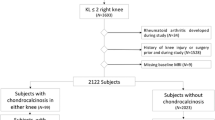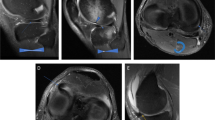Summary
To evaluate lesion detection of MRI in knee joint osteoarthritis in patients with symptoms of pain, the correlation between MRI findings and varying degrees of reported pain was assessed. Twenty-eight patients (31 knees) with osteoarthritis were recruited for this study. The degree of knee pain was assessed by VRS scores. The knees were evaluated by plain film radiograph utilizing Kellgren-Lawrence scores. Multiple MR sequences were performed on a 1.5T MR-system, including sagittal and coronal dual fast spin echo (TR/TE 3660/11/120 ms, slice thickness 5 mm), coronal spin echo T1-weighted (TR/TE 360/9 ms, slice thickness 5 mm), sagittal fat saturated 3D-spoiled gradient-recalled echo (TR/TE 50/6 ms; slice thickness 1.5 mm; flip angle 40°), and 3D steady-state free precession (TR/TE 6/2.2 ms; slice thickness 1.6 mm; flip angle 30°) pulse sequences for the purpose of detecting abnormities of cartilage, menisci, the anterior cruciate ligaments, bone marrow edema-like lesions, osteophytes, synovitis, and joint effusions. MR findings were compared with the degree of pain using Fisher exact test with P values less than 0.05 indicating a statistically significant difference. The results showed that, of the 31 knees evaluated, mild pain was reported in 11 and severe pain in the remainder. Kellgren-Lawrence scores of all 31 evaluated OA knees were as follows: grade 1 lesions (n=6), grade 2 lesions (n=14), grade 3 lesions (n=8), and grade 4 lesions (n=3). Articular cartilaginous defects were found in 37.1% of knees. Abnormalities of the menisci and anterior cruciate ligaments, bone marrow edema-like lesions, osteophytes, synovitis, and joint effusions were detected in 32.3%, 38.7%, 45.2%, 100%, 15.1% and 67.7% of knees, respectively. Of these variables, only the differences in prevalence of joint effusions were significantly different in the mild and severe pain groups (P=0.004). It is concluded that MRI evaluates the entire joint structure of the osteoarthritic knee, demonstrating abnormalities of the cartilage, menisci, and anterior cruciate ligaments as well as bone marrow edema-like lesions, osteophytes, synovitis, and joint effusions. The difference in pain grading between OA patients reporting mild and severe degrees of pain is related to the presence of joint effusion.
Similar content being viewed by others
References
Hunter DJ, Lo GH. The management of osteoarthritis: an overview and call to appropriate conservative treatment. Rheum Dis Clin North Am, 2008,34(3):689–712
Guccione AA, Felson DT, Anderson JJ, et al. The effects of specific medical conditions on the functional limitations of elders in the Framingham Study. Am J Public Health, 1994,84(3):351–358
Noyes FR, Stabler CL. A system for grading articular cartilage lesions at arthroscopy. Am J Sports Med, 1989, 17(4):505–513
Hayes CW, Jamadar DA, Welch GW, et al. Osteoarthritis of the knee comparison of MR imaging findings with radiographic severity measurements and pain in middle-aged women. Radiology, 2005,237(3): 998–1007
Link TM, Steinbach LS, Ghosh S, et al. Osteoarthritis: MR imaging findings in different stages of disease and correlation with clinical findings. Radiology, 2003,226(2): 373–381
Kornaat PR, Bloem JL, Ceulemans RY, et al. Osteo-arthritis of the knee association between clinical features and MR imaging findings. Radiology, 2006,239(3): 811–817
Schweitzer ME, Falk A, Pathria M, et al. MR imaging of the knee: can changes in the intracapsular fat pads be used as a sign of synovial proliferation in the presence of an effusion? AJR Am J Roentgenol, 1993,160(4):823–826
Felson DT, Lawrence RC, Dieppe PA, et al. Osteoarthritis: new Insights. Part 1: the disease and its risk factors. Ann Int Med, 2000,133(8):635–646
Brittberg M, Lindahl A, Nilsson A, et al. Treatment of deep cartilage defects in the knee with autologous chondrocyte transplantation. N Engl J Med, 1994, 331(14):889–895
Jakob RP, Franz T, Gautier E, et al. Autologous osteochondral grafting in the knee: indication, results, and reflections. Clin Orthop Relat Res, 2002, (401):170–184
Clegg DO, Reda DJ, Harris CL, et al. Glucosamine, chondroitin sulfate, and the two in combination for painful knee osteoarthritis. N Engl J Med, 2006,354(8):795–808.
Meredith DS, Losina E, Neumann G, et al. Empirical evaluation of the inter-relationship of articular elements involved in the pathoanatomy of knee osteoarthritis using magnetic resonance imaging. BMC Musculoskelet Disord, 2009,10:133
Ha TPT, Li KC, Beaulieu CF, et al. Anterior cruciate ligament injury: fast spin-echo MR imaging with arthroscopic correlation in 217 examinations. AJR Am J Roentgenol, 1998,170(5):1215–1219
Hill CL, Seo GS, Gale D, et al. Cruciate ligament integrity in osteoarthritis of the knee. Arthritis Rheum, 2005,52(3): 794–799
Wilson AJ, Murphy WA, Hardy DC, et al. Transient osteoporosis: transient bone marrow edema? Radiology, 1988,167(3):757–760
Kornaat PR, Kloppenburg M, Sharma R, et al. Bone marrow edema-like lesions change in volume in the majority of patients with osteoarthritis; associations with clinical features. Eur Radiol, 2007,17(12):3073–3078
Zanetti M, Bruder E, Romero J, et al. Bone marrow edema pattern in osteoarthritic knees: correlation between MR imaging and histologic findings. Radiology, 2000, 215(3):835–840
Felson DT, Niu J, Guermazi A. Correlation of the development of knee pain with enlarging bone marrow lesions on magnetic resonance imaging. Arthritis Rheum, 2007,56(9):2986–2992
Kindynis P, Haller J, Kang HS, et al. Osteophytosis of the knee: anatomic, radiologic, and pathologic investigation. Radiology, 1990,174(3 Pt 1):841–846
McCauley TR, Kornaat PR, Jee WH. Central osteophytes in the knee: prevalence and association with cartilage defects on MR imaging AJR Am J Roentgenol, 2001, 176(2):359–364
Felson DT, Gale DR, Gale ME, et al. Osteophytes and progression of knee osteoarthritis. Rheumatology, 2005,44(1):100–106
Author information
Authors and Affiliations
Corresponding author
Additional information
This project was supported by grants from the National Natural Sciences Foundation of China (No. 30670605, 30870701).
Rights and permissions
About this article
Cite this article
Ai, F., Yu, C., Zhang, W. et al. MR imaging of knee osteoarthritis and correlation of findings with reported patient pain. J. Huazhong Univ. Sci. Technol. [Med. Sci.] 30, 248–254 (2010). https://doi.org/10.1007/s11596-010-0223-0
Received:
Published:
Issue Date:
DOI: https://doi.org/10.1007/s11596-010-0223-0




